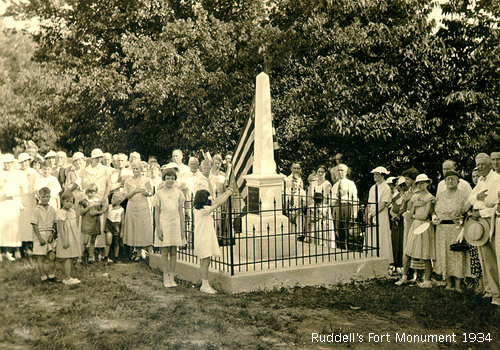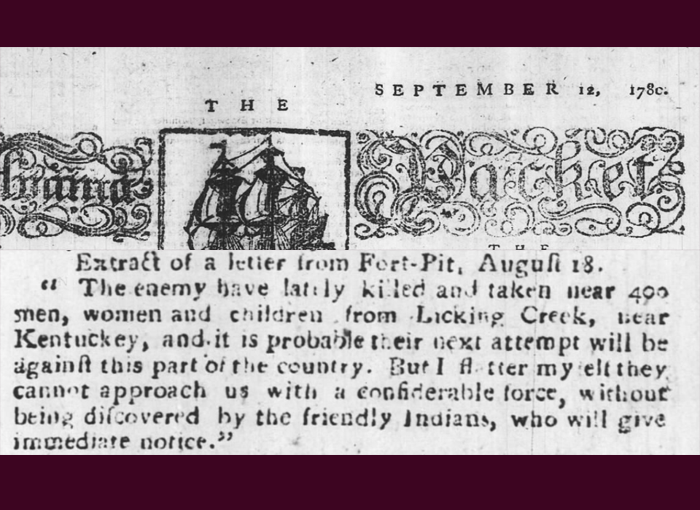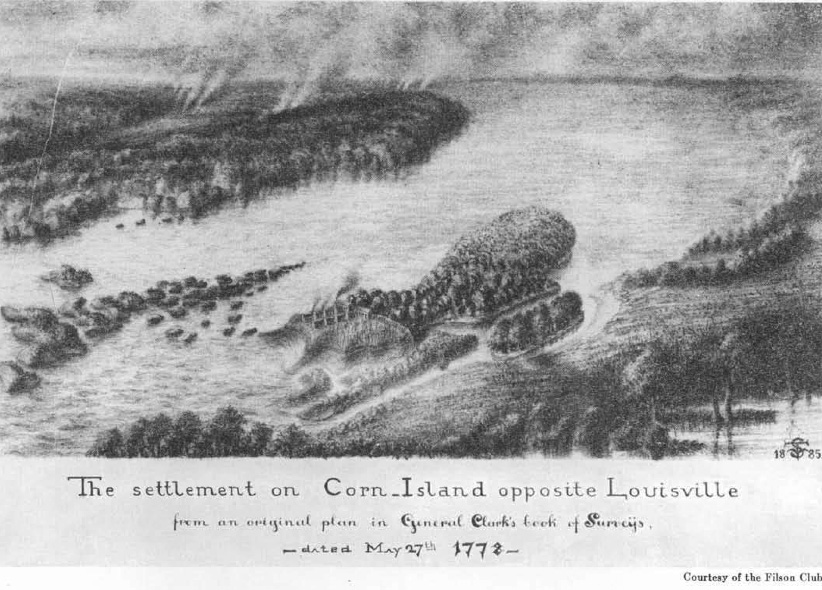 |
 Courtesy of Mr. & Mrs. Jerry Taylor Courtesy of Mr. & Mrs. Jerry Taylor |
|
|
Isaac Ruddell was born in Nottingham Township, Chester Co. Pennsylvania around 1730. He was a younger son of John & Mary (Cook) Ruddell. Isaac's oldest brother: John, was about 14 when Isaac was born, another brother Cornelius was about 13, Stephen was about 5 and Archibald was 2 or 3 years old. The following siblings: 3 sisters and 1 more brother (Goerge) would bring the balance of the family. When Isaac was 19 or 20 years old, his oldest brother John Jr. died at the age of 33, while the youngest brother George was about 10 years old.
According to Kirk B. Barb's "History & Genealogy of the Ruddle Family," in the year 1750 Isaac Ruddell purchased a tract of land in Frederick County, Va. Isaac married Elizabeth Bowman, who was the granddaugher of Joist Hite a German immigrant and prominent landowner in Colonial Virginia. Isaac and Elizabeth lived together in Frederick County, or at least held land there until 1769, according again to Barb's text which quotes a deposition made by Isaac Ruddell in 1799, aged 69, he said that he lived "on the River Holston near the dividing lines of Virginia and North Carolina... where he was until 1778 when he removed to Kentucky." The Virginia Historical Magazine, Vol. VIII, page 18, according to Kirk B. Barb, "shows that on May 25, 1778 a certain sum of money was paid to Isaac for his Company at Washington (County) Militia to be sent under Col. George Rogers Clark to fight the British and Indians in Kentucky, and Illinois."

The Isaac Ruddell family in 1778 consisted of John, Isaac Jr., George, who was born in 1757 and would have been 21 years old, Cornelius, Stephen A. (who was born in 1768,) who was 10, Abraham who was born in 1774; then Elizabeth Ruddell who was born August 26, 1776 in Virginia and she would have been two.
Capt. Isaac Ruddell served George Rogers Clark, and was stationed at Corn Island (which is now submerged) during the American Revolution. Isaac was in his 40's, and his brothers-in-law (the Bowmans) were prominent soldiers (at one point Joseph Bowman was George Rogers Clark's second in command.) Isaac Ruddell re-fortified Hinkston's Station, in 1779. The fort became: Ruddell's Fort, which was part of a network of American forts during the Revolution. George Rogers Clark dealt the British a hard blow, when he took Vincennes. Additionally, John Bowman killed Chief Black Fish in 1779. So, British and Native American forces focused on hitting back. Attacks by Natives were one reason the Hinkston Station was abandoned, according to several researchers. Early in 1780 Natives made advances on Ruddell's Fort and were repelled. However, in June of 1780 a large force, believed to be composed of several hundred Native warriors, and British soldiers with canons, attacked the Ruddell's Fort.
It is believed Captain Isaac Ruddell, who was out numbered and out gunned, as the British brought cannons and the fort had none, negotiated a peaceful settlement as long as the soldiers and their families were taken into British custody. According to several accounts, upon opening the gates to the fort the Native warriors rushed in. An infant of Isaac and Elizabeth's is recorded to have been killed during the invasion, where Captain Isaac Ruddell, Elizabeth, their son George, and daughter-in-law Theodosia as well as Stephen & Abraham were taken prisoners, along with their cousins John & James, who were sons of Archibald Ruddell, Isaac's older brother; as well as Archibald's daughter Sarah and her husband to be Thomas Davis. Isaac's nephew, John died in British custody enroute to Canada, just a day or two after the Ruddell's Fort was attacked. The Ruddell's Fort soldiers and families carried those wounded during the invasion for hundreds of miles under grueling conditions.

The Ruddell family members along with several other families were forced to march to Detroit, and then taken to Canada. A few of the children, including Stephen and Abraham were "adopted," into Native American families. Stephen and Abraham lived with the Shawnee for over a dozen years. The remainder of the prisoners in British custody were released and exchanged through the end of the Revolution. Letters to both James Madison and George Washington (*Draper Notes I0S:81-83 Letter of Gov. Benjamin Harrison to George Washington regarding the release of Kentucky prisoners, Oct. 25, 1782.) regarding the prisoners taken from Ruddell's Fort are among a few of the interesting historical artifacts that describe events surrounding the American & British confrontation at Ruddell's Fort in 1780, which the British called "Fort Liberty." While Isaac was held prisoner by the British, his father, the patriarch of the Ruddell family, John Ruddell Sr. died in Shenandoah Valley, Virginia around the age of 86.
Isaac Ruddell was a very experienced military man. He faced unique obstacles, given the fact he was responsible for entire families of women, and children in a time of war. Everyone who was able to contribute, to defending the fort, did what they could; one soldier, John McFall sniped out a British officer at the early stages of the confrontation in June, 1780. Both the British and Natives were very harsh on the prisoners they took, while Isaac and his family were afforded better living conditions while being held by the British. They also had just had one of their children killed, one nephew killed and two sons taken away by the Shawnee. The notion that Isaac or Elizabeth had any sympathies for the British cause are simply misplaced -- however, those were alleged, because a few of the soldiers & families who were taken prisoner specifically felt Isaac did not do everything in his power to defend the prisoners (one incident specifically involved Lt. Ravenscraft.) Prisoners like Ravenscraft were forced to "run the gauntlet" which was a very grueling task, and the British were notorious for maltreatment of the prisoners they took (prison ships are a good example of such harsh treatment of American soldiers, keep in mind Captain Henry Bird, who led the attack of Ruddell's Fort is said to have married one of the prisoners: "He married at Detroit to a prisoner and received land from the government, but lost it in 1794 when Fort Ameherstbugh was ordered to be built on the site".)
After the Treaty of Paris in 1783 all of the prisoners were let go. Isaac returned to Virginia and was put on trial briefly, as most commanders of forts that surrendered were. Isaac was acquitted, however the magistrate had harsh words for him; some blamed him. Isaac and his family returned to the area of Ruddell's Fort and re-built. About 12 years after they returned and built their home, two of their sons who had been taken in June of 1780, Stephen and Abraham were freed by the Treaty of Greensville (1795), negotiated by General Anthony Wayne.
Isaac engaged in a few different businesses, including the production of whiskey and farming. Elizabeth tended a peach orchard at their home, just about 5 miles from the site of the Ruddell's Fort, where they lived at the confluence of the Licking, Stoner and Hinkston rivers in Ruddle's Mills, Kentucky. Several pioneer homes, including Isaac's stand to this day, amid vast, rolling Kentucky farms in Ruddle's Mills. Isaac had a place he could have easily stayed at, away from the conflicts and hardships, in Virginia at the Ruddell family farm. He chose instead to return to the area of the Ruddell's Fort and work on, what he must have felt was, his duty and responsibility.
Ironically, Isaac died in 1812 as another major war was on the horizon. One that his family would also fight in. By then Isaac was about 80 years old, and actively participated in a major turning point in American history. His sons and grandsons were early settlers in Arkansas and Washington Territory, they also moved into Texas and California.
_____________________
'Shawnee Names: Big to Black' by Don Greene (regarding Isaac's son)
"Puckenshinwa aka Alights from Flying-I Alight From Flying - 1/2 Shawnee-Creek Metis born about 1725 AL-died 1774 WV - French-Indian War, Braddock, Pontiac War, Bushy Run, raiding New-Greenbrier-Jackson River valleys 1763, raiding Ohio-Little Kanawha-Big Sandy-New River valleys 1772, killed at Point Pleasant 1774, Grand Council June 1762, Sept. 1762, 1763, Council Bouquet Oct. 1764, son of Daughter of James McQueen-1/2 Creek Metis & Kishpoko Shawnee Man, husband of Metheotashe-Pekowi Shawnee, father of sons Cheeseekau/56, Sauwaseekou/59, Nahaaseema/65, Tecumseh/68, Kumshaka/70, Tenskawatawa/74 & daughters Tecumapease/58, Menewaulakoose/66, Vocemassussia/71-all 3/4th Shawnee-Creek Metis, adopted father of Joshua Renicks/46 (60), John Sparks/60 (68) & Richard Sparks/60 (68), Stephen Ruddell/67 (before 74)"











